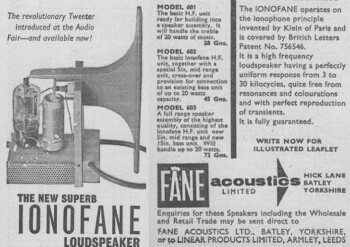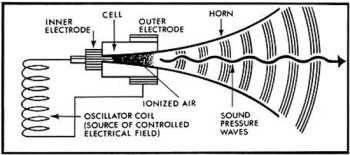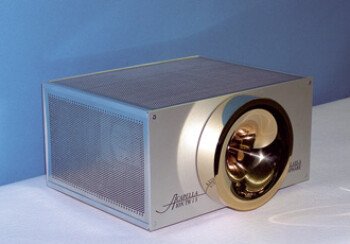In this chapter we'll discuss a not-so-widely spread category of transducers based on very amazing principles. They can make some people dream because they are freed from the mechanical stages of transduction – although it comes at a cost.

In 1900, English engineer W. Durdell experimented with the possibility to modulate the sound emitted by an arc lamp (which were used as street lights back then). By tuning the circuit and connecting it to a keyboard he was able to create a singing arc. He played a demo performing “God save the Queen” with what could be considered the first electronic instrument in history. The ability of air to emit sound waves when subjected to an intense electric field was thus demonstrated. Half a century later, the idea to use this technology to make a loudspeaker inspired French inventor Siegfried Klein to conceive the first commercial plasma tweeters:
Operation

Their operation is based on the capacity of a gas to be ionized when subjected to an intense electric field. In practice, two electrodes are placed one in front of the other. When you apply a voltage difference of several hundred volts to the electrodes, the molecules of the surrounding gas produce ions (electrically charged molecules: the number of electrons is not the same as the number of protons). It is this group of ions that’s called plasma. Right at that moment the electrical resistance of the gas rises steeply and the discharge produces a luminescent halo. This state is held while the voltage difference persists and the electrodes aren’t vaporized.
Within the plasma loudspeaker, the current that charges the electrode alternates at high frequencies (several megahertz), while the gas is ionized and gets hot. The amplitude of the high-frequency current is then modulated by the audio signal. The thermal agitation of the molecules varies depending on the amplitude of the discharge current. The pressure variations of the gas molecules follow the signal variations producing a sound wave, without any mechanical aid. No mobile pieces, diaphragms or ceramics. It is the air alone that produces the acoustic energy by contracting and expanding.
Advantages and disadvantages

Despite the promise of not using a diaphragm, the amount of pressurized air being not too important, the maximum pressure level and the ability to produce low frequencies are compromised. The ideal frequency range goes from high frequencies to ultrasounds. Several models have been marketed since the '50s and their intrinsic qualities (exceptional transient response and distortion rate, omni polar pattern, wide frequency range in the high end) have seduced a lot of relentless supporters of the concept.
However, several obstacles have stopped this technology from being adopted by a wider audience. The plasma appears with high voltages only, which might be potentially dangerous if the necessary precautions are not taken. Further, the electrodes get very hot and end up vaporizing, thus limiting the lifetime of the cells, which are not particularly cheap to manufacture. Finally, plasma speakers have the tendency to produce waste in the form of toxic gases, such as ozone and nitrogen oxide. Sometimes, the amount of these gases can be enough to pose a health threat inside a room.

With this we close this brief overview of the main transducers found in loudspeakers. There are some experimental cases and variations that we didn’t cover, but you are more than free to look into them. The history of loudspeakers and PA systems is rich in particular (and individual) projects and initiatives. The goal behind this “Getting Started” series is to give you a basic overview of the different speaker families that have been marketed but without losing sight that every part could be the object of a much more in-depth analysis, which is out of the scope of this series.
